FORD MUSTANG 2011 5.G Owners Manual
Manufacturer: FORD, Model Year: 2011, Model line: MUSTANG, Model: FORD MUSTANG 2011 5.GPages: 348, PDF Size: 2.65 MB
Page 231 of 348
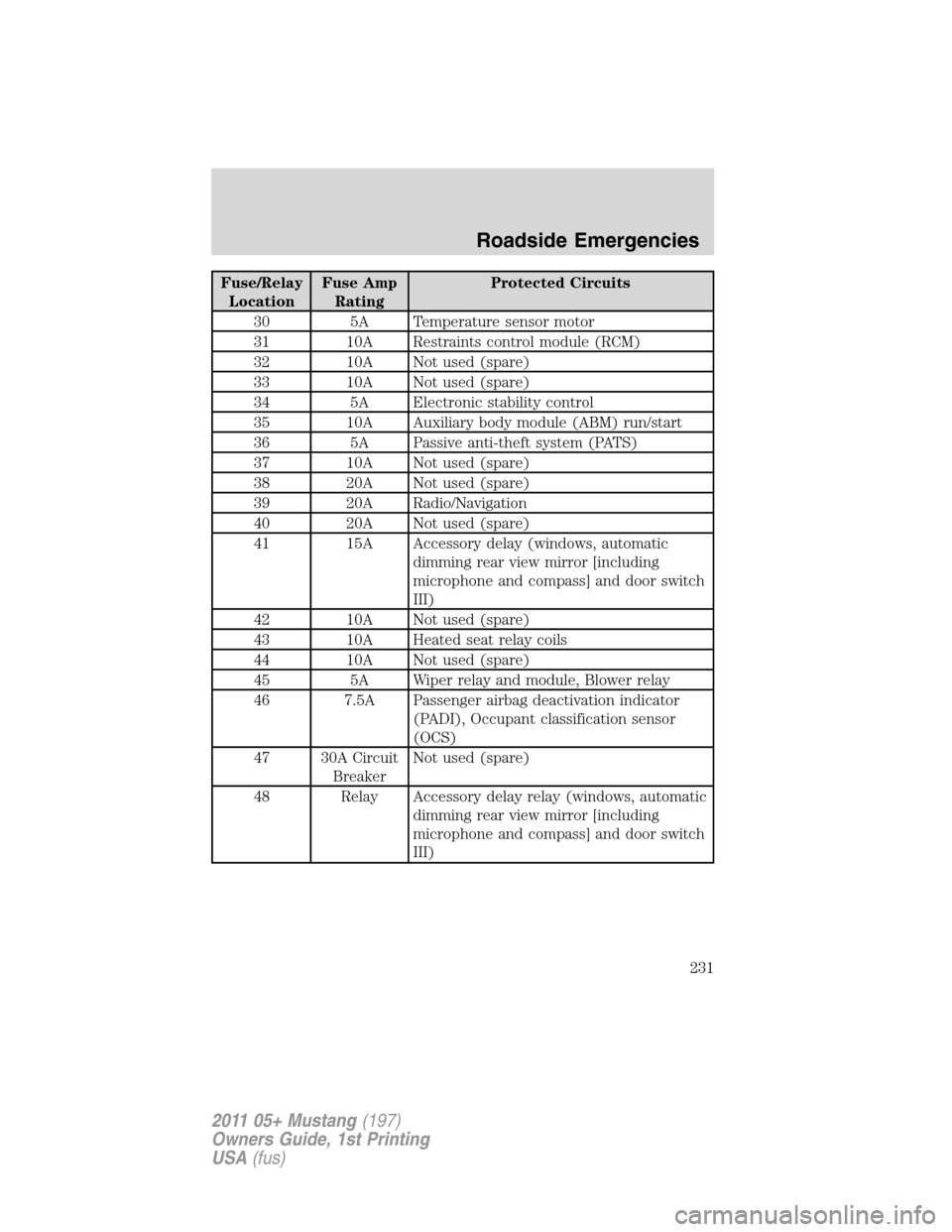
Fuse/Relay
LocationFuse Amp
RatingProtected Circuits
30 5A Temperature sensor motor
31 10A Restraints control module (RCM)
32 10A Not used (spare)
33 10A Not used (spare)
34 5A Electronic stability control
35 10A Auxiliary body module (ABM) run/start
36 5A Passive anti-theft system (PATS)
37 10A Not used (spare)
38 20A Not used (spare)
39 20A Radio/Navigation
40 20A Not used (spare)
41 15A Accessory delay (windows, automatic
dimming rear view mirror [including
microphone and compass] and door switch
III)
42 10A Not used (spare)
43 10A Heated seat relay coils
44 10A Not used (spare)
45 5A Wiper relay and module, Blower relay
46 7.5A Passenger airbag deactivation indicator
(PADI), Occupant classification sensor
(OCS)
47 30A Circuit
BreakerNot used (spare)
48 Relay Accessory delay relay (windows, automatic
dimming rear view mirror [including
microphone and compass] and door switch
III)
Roadside Emergencies
231
2011 05+ Mustang(197)
Owners Guide, 1st Printing
USA(fus)
Page 232 of 348
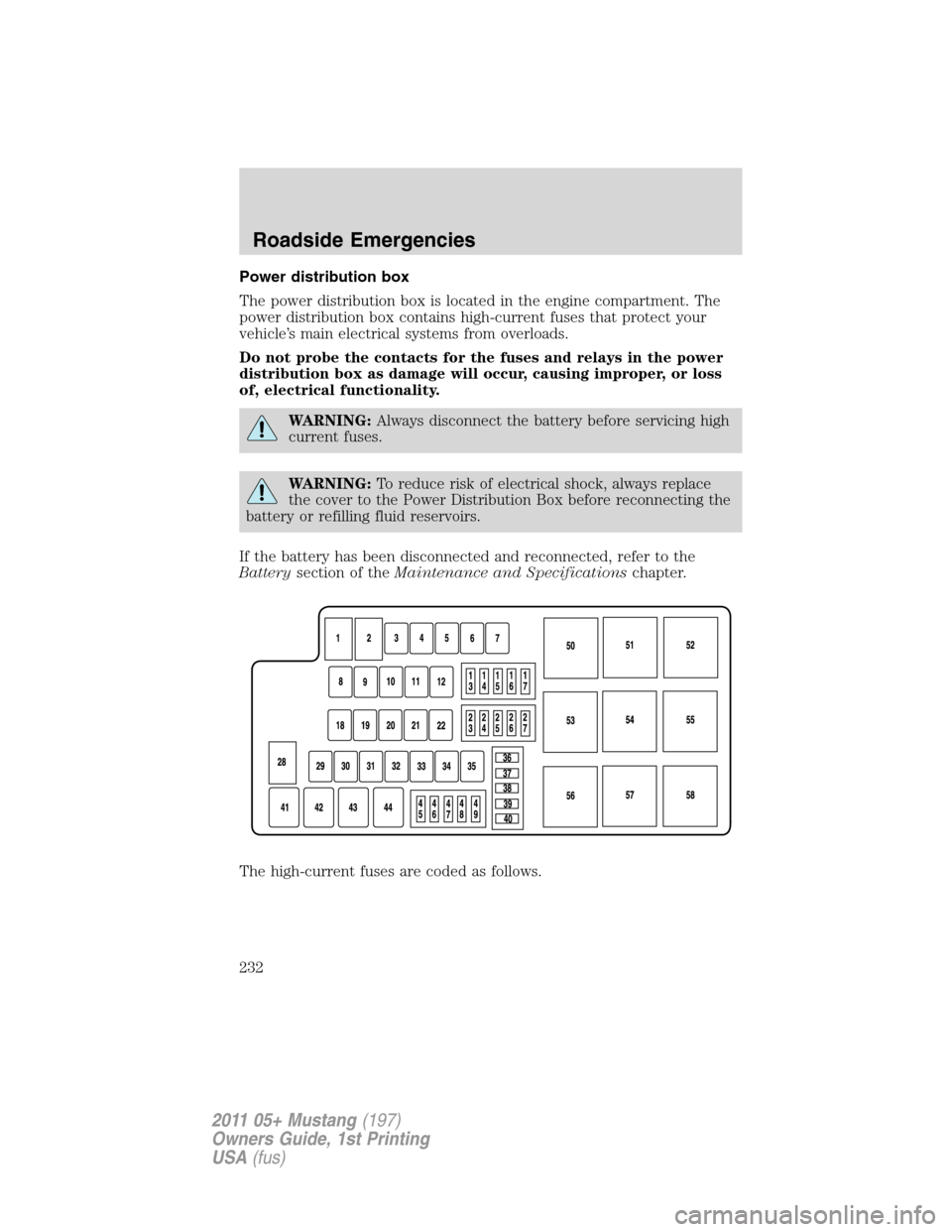
Power distribution box
The power distribution box is located in the engine compartment. The
power distribution box contains high-current fuses that protect your
vehicle’s main electrical systems from overloads.
Do not probe the contacts for the fuses and relays in the power
distribution box as damage will occur, causing improper, or loss
of, electrical functionality.
WARNING:Always disconnect the battery before servicing high
current fuses.
WARNING:To reduce risk of electrical shock, always replace
the cover to the Power Distribution Box before reconnecting the
battery or refilling fluid reservoirs.
If the battery has been disconnected and reconnected, refer to the
Batterysection of theMaintenance and Specificationschapter.
The high-current fuses are coded as follows.
Roadside Emergencies
232
2011 05+ Mustang(197)
Owners Guide, 1st Printing
USA(fus)
Page 233 of 348
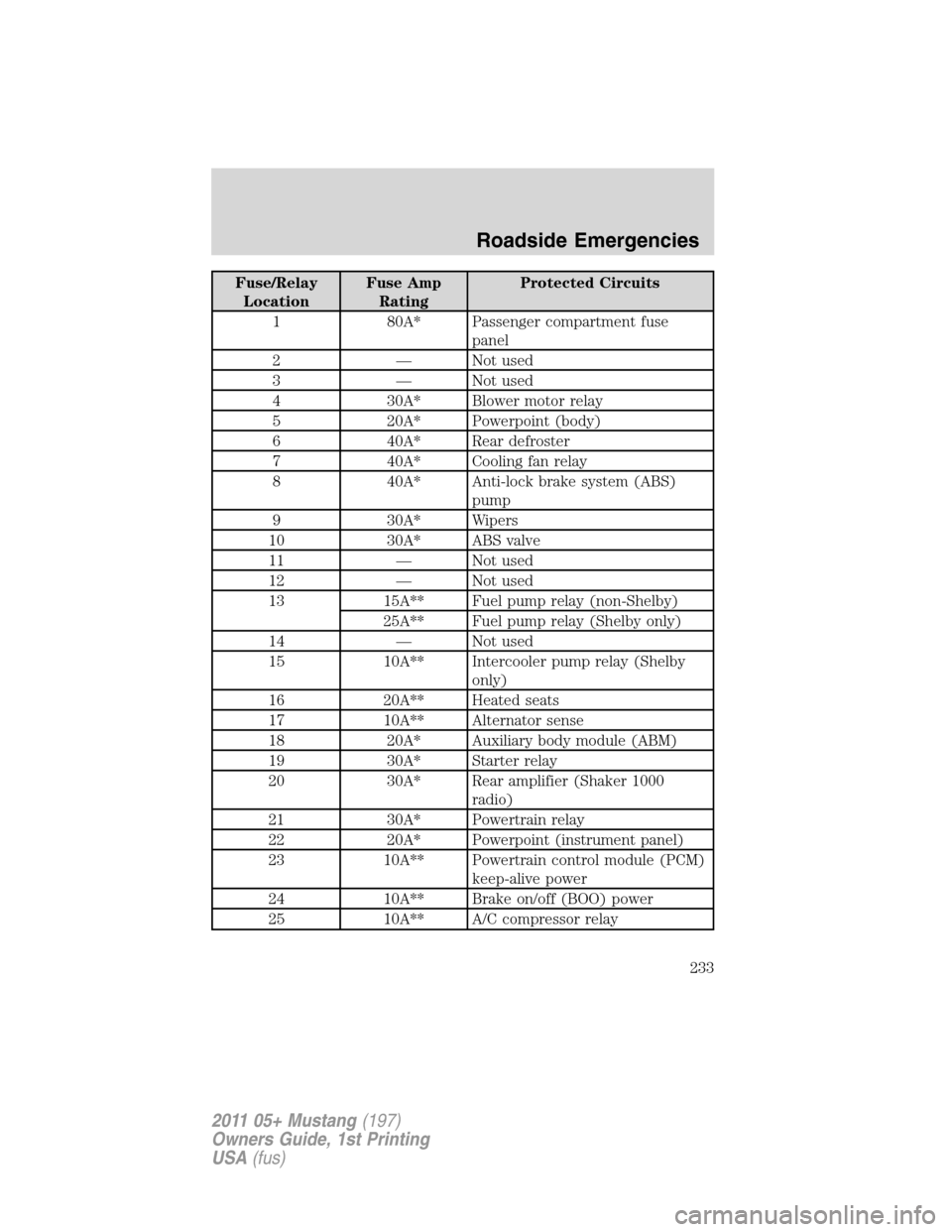
Fuse/Relay
LocationFuse Amp
RatingProtected Circuits
1 80A* Passenger compartment fuse
panel
2 — Not used
3 — Not used
4 30A* Blower motor relay
5 20A* Powerpoint (body)
6 40A* Rear defroster
7 40A* Cooling fan relay
8 40A* Anti-lock brake system (ABS)
pump
9 30A* Wipers
10 30A* ABS valve
11 — Not used
12 — Not used
13 15A** Fuel pump relay (non-Shelby)
25A** Fuel pump relay (Shelby only)
14 — Not used
15 10A** Intercooler pump relay (Shelby
only)
16 20A** Heated seats
17 10A** Alternator sense
18 20A* Auxiliary body module (ABM)
19 30A* Starter relay
20 30A* Rear amplifier (Shaker 1000
radio)
21 30A* Powertrain relay
22 20A* Powerpoint (instrument panel)
23 10A** Powertrain control module (PCM)
keep-alive power
24 10A** Brake on/off (BOO) power
25 10A** A/C compressor relay
Roadside Emergencies
233
2011 05+ Mustang(197)
Owners Guide, 1st Printing
USA(fus)
Page 234 of 348
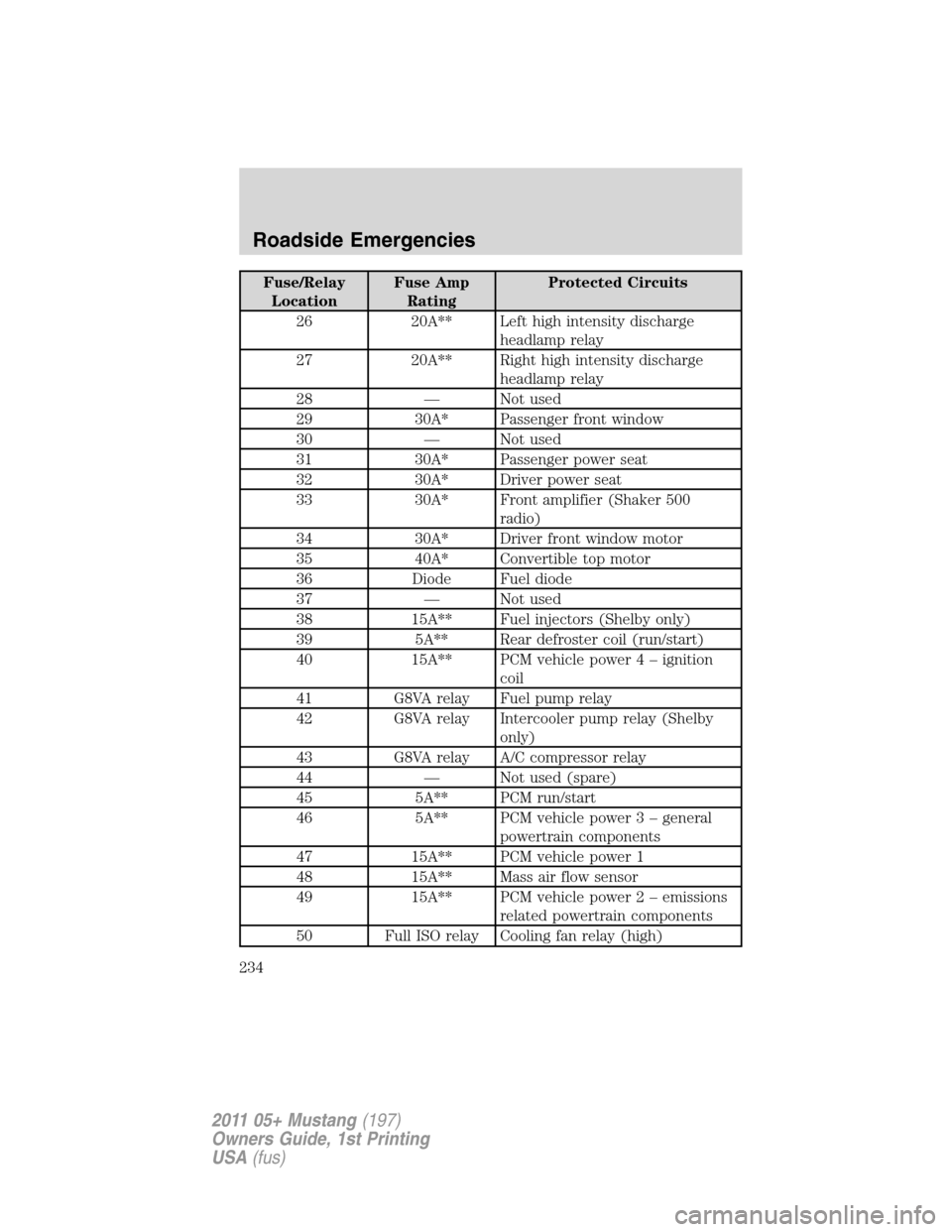
Fuse/Relay
LocationFuse Amp
RatingProtected Circuits
26 20A** Left high intensity discharge
headlamp relay
27 20A** Right high intensity discharge
headlamp relay
28 — Not used
29 30A* Passenger front window
30 — Not used
31 30A* Passenger power seat
32 30A* Driver power seat
33 30A* Front amplifier (Shaker 500
radio)
34 30A* Driver front window motor
35 40A* Convertible top motor
36 Diode Fuel diode
37 — Not used
38 15A** Fuel injectors (Shelby only)
39 5A** Rear defroster coil (run/start)
40 15A** PCM vehicle power4–ignition
coil
41 G8VA relay Fuel pump relay
42 G8VA relay Intercooler pump relay (Shelby
only)
43 G8VA relay A/C compressor relay
44 — Not used (spare)
45 5A** PCM run/start
46 5A** PCM vehicle power 3 – general
powertrain components
47 15A** PCM vehicle power 1
48 15A** Mass air flow sensor
49 15A** PCM vehicle power 2 – emissions
related powertrain components
50 Full ISO relay Cooling fan relay (high)
Roadside Emergencies
234
2011 05+ Mustang(197)
Owners Guide, 1st Printing
USA(fus)
Page 235 of 348
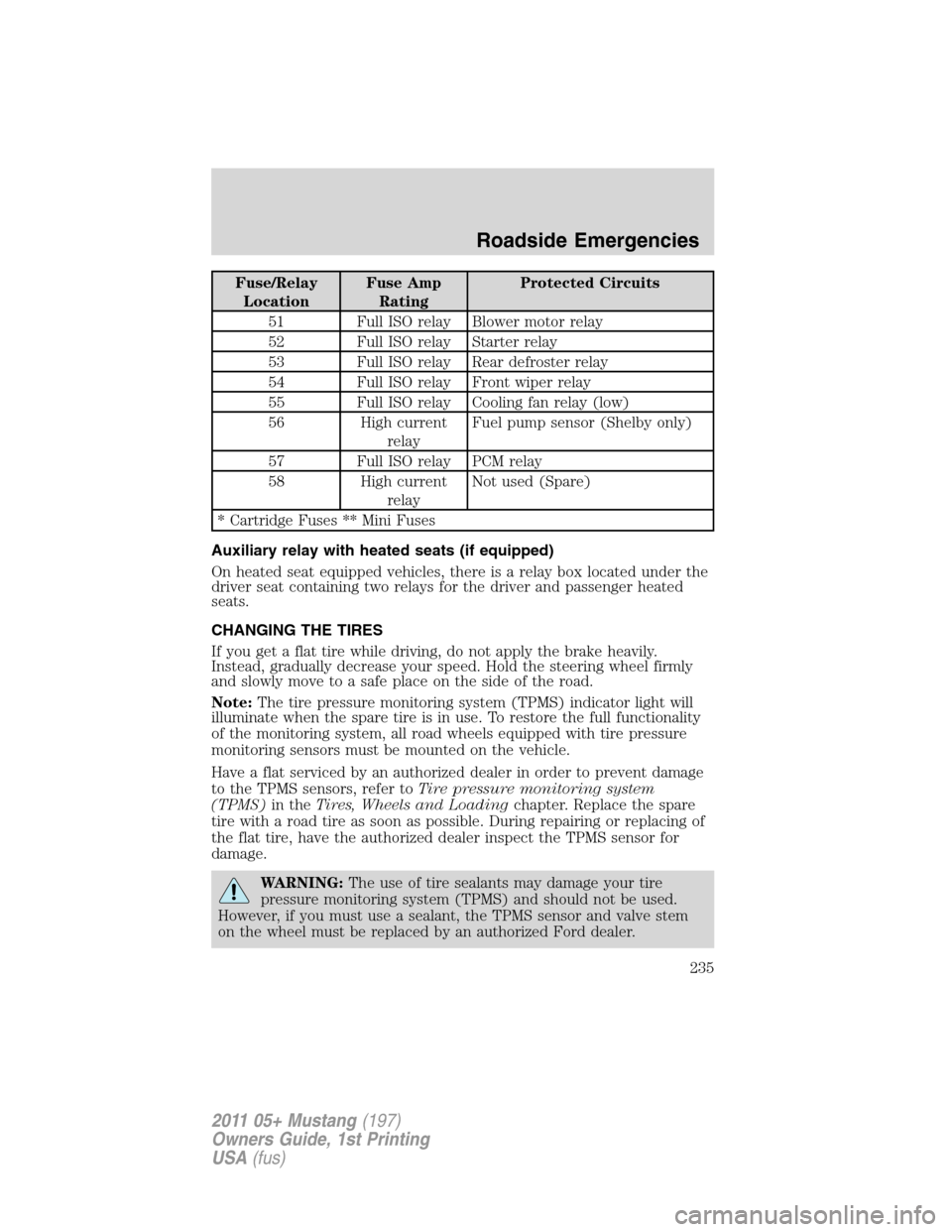
Fuse/Relay
LocationFuse Amp
RatingProtected Circuits
51 Full ISO relay Blower motor relay
52 Full ISO relay Starter relay
53 Full ISO relay Rear defroster relay
54 Full ISO relay Front wiper relay
55 Full ISO relay Cooling fan relay (low)
56 High current
relayFuel pump sensor (Shelby only)
57 Full ISO relay PCM relay
58 High current
relayNot used (Spare)
* Cartridge Fuses ** Mini Fuses
Auxiliary relay with heated seats (if equipped)
On heated seat equipped vehicles, there is a relay box located under the
driver seat containing two relays for the driver and passenger heated
seats.
CHANGING THE TIRES
If you get a flat tire while driving, do not apply the brake heavily.
Instead, gradually decrease your speed. Hold the steering wheel firmly
and slowly move to a safe place on the side of the road.
Note:The tire pressure monitoring system (TPMS) indicator light will
illuminate when the spare tire is in use. To restore the full functionality
of the monitoring system, all road wheels equipped with tire pressure
monitoring sensors must be mounted on the vehicle.
Have a flat serviced by an authorized dealer in order to prevent damage
to the TPMS sensors, refer toTire pressure monitoring system
(TPMS)in theTires, Wheels and Loadingchapter. Replace the spare
tire with a road tire as soon as possible. During repairing or replacing of
the flat tire, have the authorized dealer inspect the TPMS sensor for
damage.
WARNING:The use of tire sealants may damage your tire
pressure monitoring system (TPMS) and should not be used.
However, if you must use a sealant, the TPMS sensor and valve stem
on the wheel must be replaced by an authorized Ford dealer.
Roadside Emergencies
235
2011 05+ Mustang(197)
Owners Guide, 1st Printing
USA(fus)
Page 236 of 348
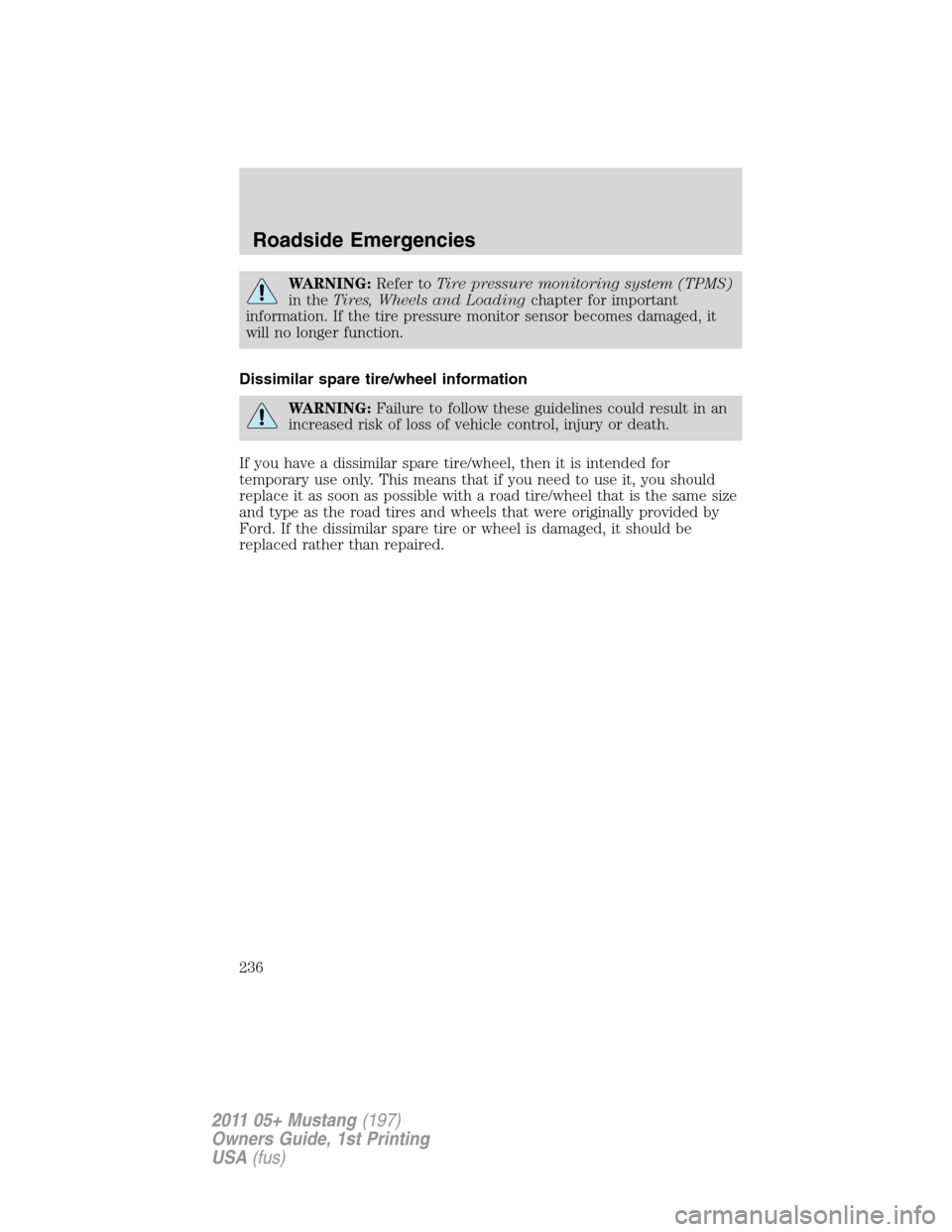
WARNING:Refer toTire pressure monitoring system (TPMS)
in theTires, Wheels and Loadingchapter for important
information. If the tire pressure monitor sensor becomes damaged, it
will no longer function.
Dissimilar spare tire/wheel information
WARNING:Failure to follow these guidelines could result in an
increased risk of loss of vehicle control, injury or death.
If you have a dissimilar spare tire/wheel, then it is intended for
temporary use only. This means that if you need to use it, you should
replace it as soon as possible with a road tire/wheel that is the same size
and type as the road tires and wheels that were originally provided by
Ford. If the dissimilar spare tire or wheel is damaged, it should be
replaced rather than repaired.
Roadside Emergencies
236
2011 05+ Mustang(197)
Owners Guide, 1st Printing
USA(fus)
Page 237 of 348
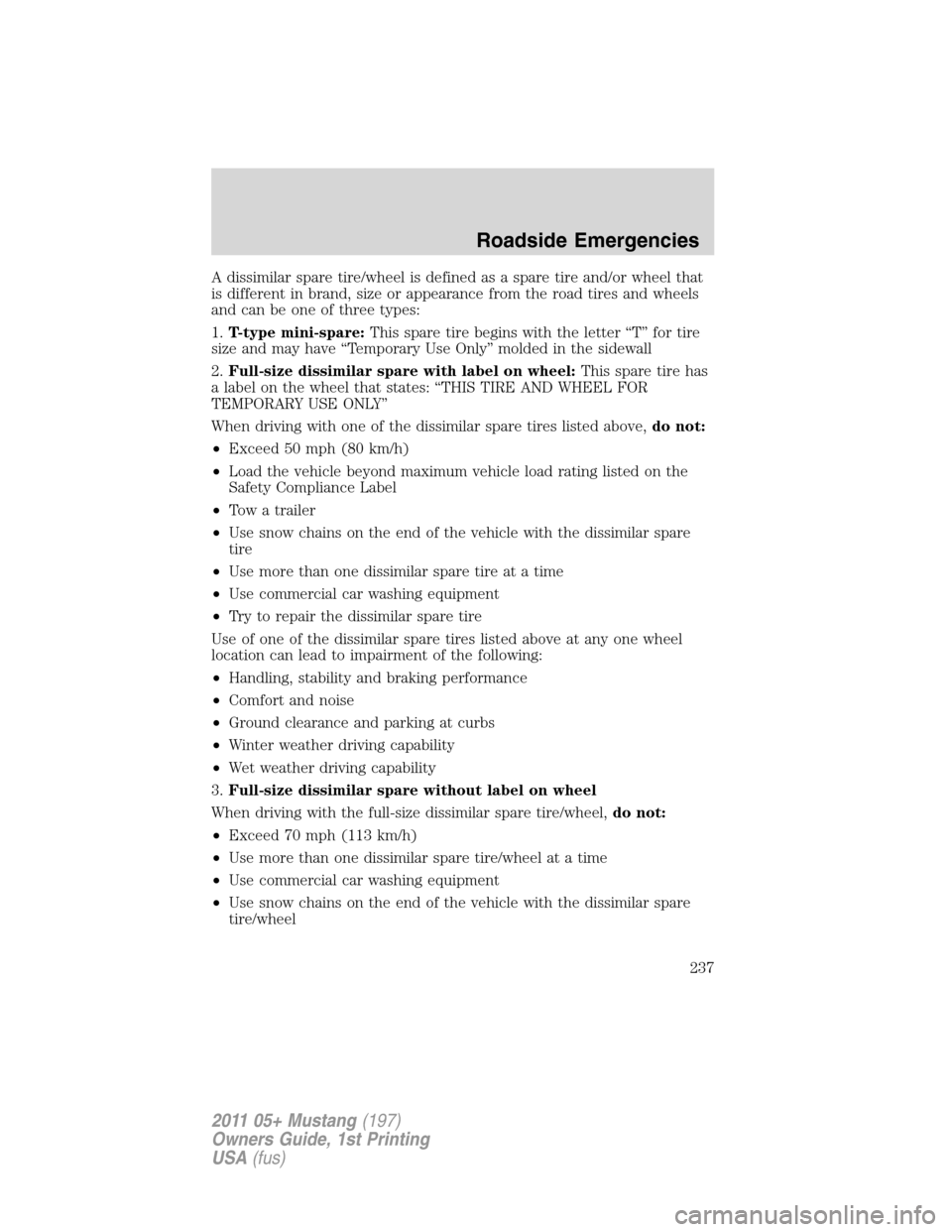
A dissimilar spare tire/wheel is defined as a spare tire and/or wheel that
is different in brand, size or appearance from the road tires and wheels
and can be one of three types:
1.T-type mini-spare:This spare tire begins with the letter “T” for tire
size and may have “Temporary Use Only” molded in the sidewall
2.Full-size dissimilar spare with label on wheel:This spare tire has
a label on the wheel that states: “THIS TIRE AND WHEEL FOR
TEMPORARY USE ONLY”
When driving with one of the dissimilar spare tires listed above,do not:
•Exceed 50 mph (80 km/h)
•Load the vehicle beyond maximum vehicle load rating listed on the
Safety Compliance Label
•Tow a trailer
•Use snow chains on the end of the vehicle with the dissimilar spare
tire
•Use more than one dissimilar spare tire at a time
•Use commercial car washing equipment
•Try to repair the dissimilar spare tire
Use of one of the dissimilar spare tires listed above at any one wheel
location can lead to impairment of the following:
•Handling, stability and braking performance
•Comfort and noise
•Ground clearance and parking at curbs
•Winter weather driving capability
•Wet weather driving capability
3.Full-size dissimilar spare without label on wheel
When driving with the full-size dissimilar spare tire/wheel,do not:
•Exceed 70 mph (113 km/h)
•Use more than one dissimilar spare tire/wheel at a time
•Use commercial car washing equipment
•Use snow chains on the end of the vehicle with the dissimilar spare
tire/wheel
Roadside Emergencies
237
2011 05+ Mustang(197)
Owners Guide, 1st Printing
USA(fus)
Page 238 of 348
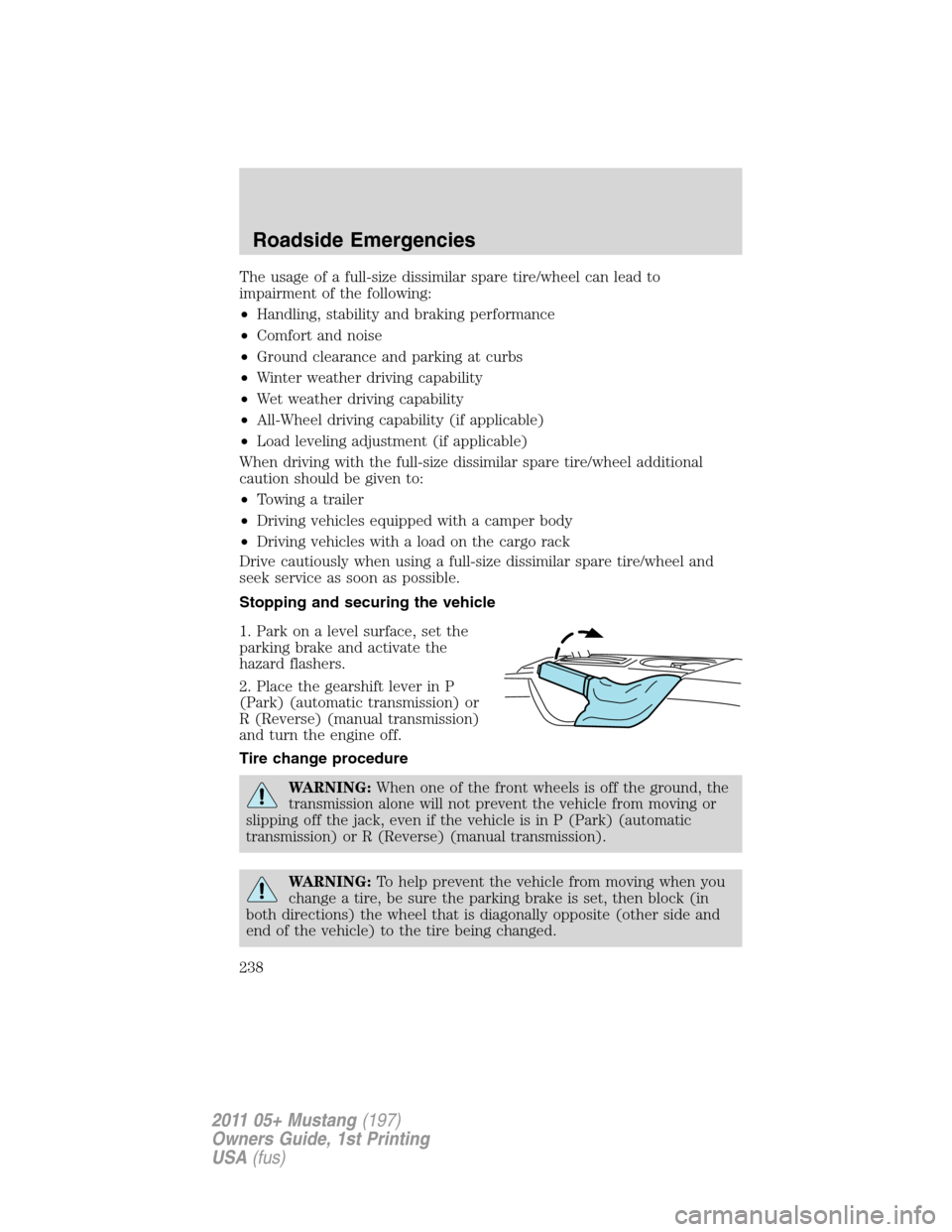
The usage of a full-size dissimilar spare tire/wheel can lead to
impairment of the following:
•Handling, stability and braking performance
•Comfort and noise
•Ground clearance and parking at curbs
•Winter weather driving capability
•Wet weather driving capability
•All-Wheel driving capability (if applicable)
•Load leveling adjustment (if applicable)
When driving with the full-size dissimilar spare tire/wheel additional
caution should be given to:
•Towing a trailer
•Driving vehicles equipped with a camper body
•Driving vehicles with a load on the cargo rack
Drive cautiously when using a full-size dissimilar spare tire/wheel and
seek service as soon as possible.
Stopping and securing the vehicle
1. Park on a level surface, set the
parking brake and activate the
hazard flashers.
2. Place the gearshift lever in P
(Park) (automatic transmission) or
R (Reverse) (manual transmission)
and turn the engine off.
Tire change procedure
WARNING:When one of the front wheels is off the ground, the
transmission alone will not prevent the vehicle from moving or
slipping off the jack, even if the vehicle is in P (Park) (automatic
transmission) or R (Reverse) (manual transmission).
WARNING:To help prevent the vehicle from moving when you
change a tire, be sure the parking brake is set, then block (in
both directions) the wheel that is diagonally opposite (other side and
end of the vehicle) to the tire being changed.
Roadside Emergencies
238
2011 05+ Mustang(197)
Owners Guide, 1st Printing
USA(fus)
Page 239 of 348
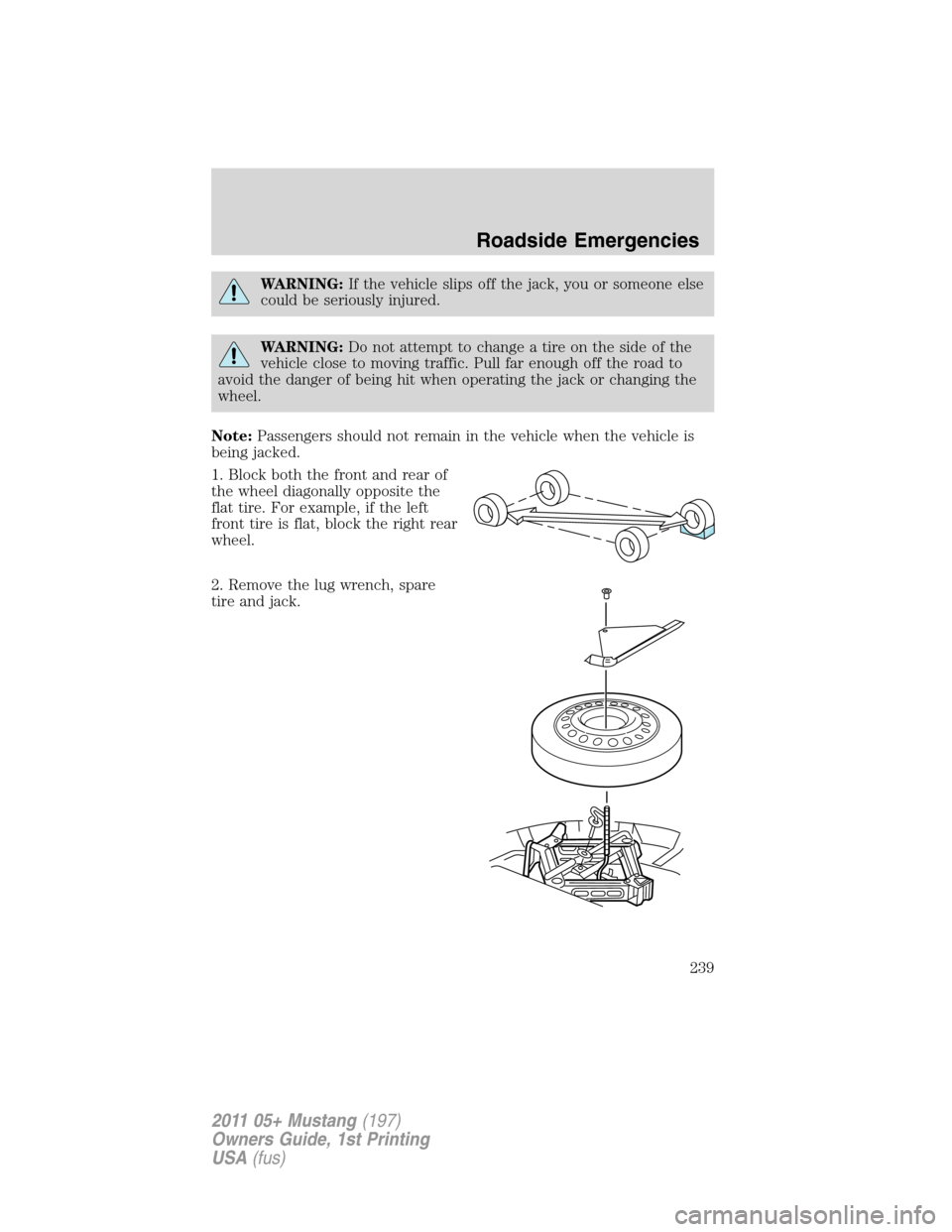
WARNING:If the vehicle slips off the jack, you or someone else
could be seriously injured.
WARNING:Do not attempt to change a tire on the side of the
vehicle close to moving traffic. Pull far enough off the road to
avoid the danger of being hit when operating the jack or changing the
wheel.
Note:Passengers should not remain in the vehicle when the vehicle is
being jacked.
1. Block both the front and rear of
the wheel diagonally opposite the
flat tire. For example, if the left
front tire is flat, block the right rear
wheel.
2. Remove the lug wrench, spare
tire and jack.
Roadside Emergencies
239
2011 05+ Mustang(197)
Owners Guide, 1st Printing
USA(fus)
Page 240 of 348
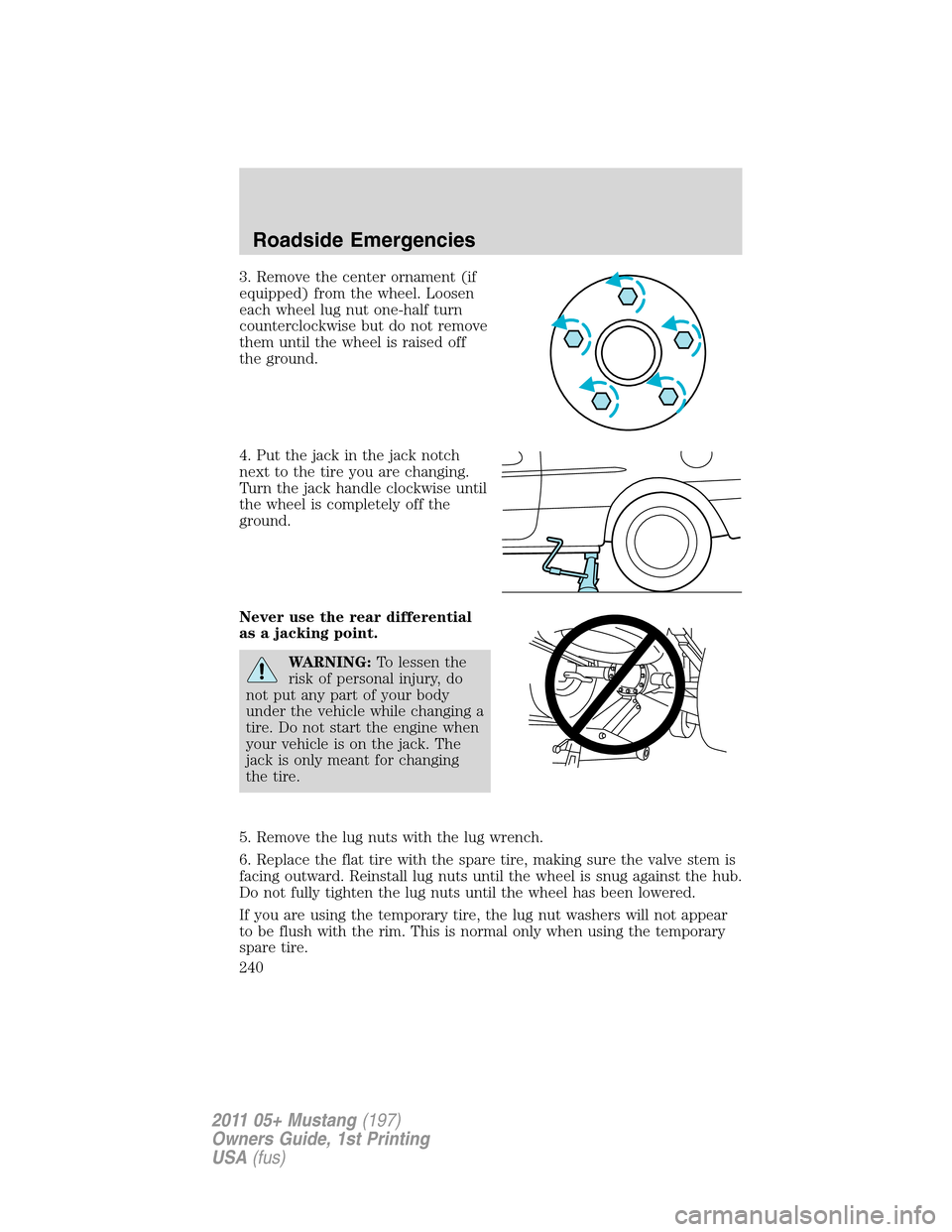
3. Remove the center ornament (if
equipped) from the wheel. Loosen
each wheel lug nut one-half turn
counterclockwise but do not remove
them until the wheel is raised off
the ground.
4. Put the jack in the jack notch
next to the tire you are changing.
Turn the jack handle clockwise until
the wheel is completely off the
ground.
Never use the rear differential
as a jacking point.
WARNING:To lessen the
risk of personal injury, do
not put any part of your body
under the vehicle while changing a
tire. Do not start the engine when
your vehicle is on the jack. The
jack is only meant for changing
the tire.
5. Remove the lug nuts with the lug wrench.
6. Replace the flat tire with the spare tire, making sure the valve stem is
facing outward. Reinstall lug nuts until the wheel is snug against the hub.
Do not fully tighten the lug nuts until the wheel has been lowered.
If you are using the temporary tire, the lug nut washers will not appear
to be flush with the rim. This is normal only when using the temporary
spare tire.
Roadside Emergencies
240
2011 05+ Mustang(197)
Owners Guide, 1st Printing
USA(fus)